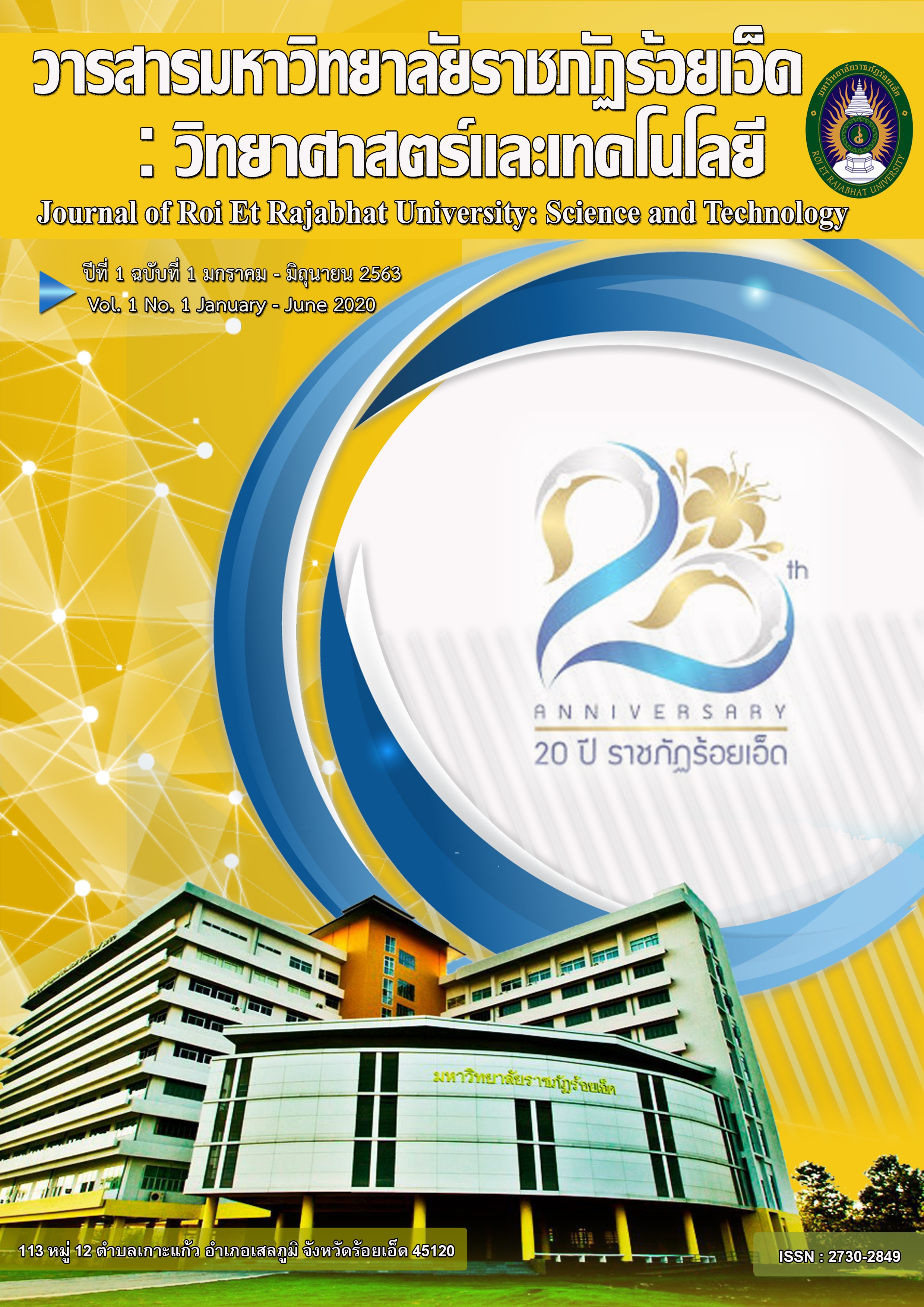สารประกอบฟีนอลิกและความสามารถในการต้านอนุมูลอิสระของสารสกัดสมุนไพรไทย บางชนิด
คำสำคัญ:
ตำลึงทอง, ผักคราดหัวแหวน, หญ้างวงช้าง, สารประกอบฟีนอลิก, สารต้านอนุมูลอิสระบทคัดย่อ
การศึกษาครั้งนี้มีวัตถุประสงค์เพื่อวิเคราะห์สารประกอบฟีนอลิก และฤทธิ์ต้านอนุมูลอิสระ พืชสมุนไพรไทย 3 ชนิด ได้แก่ หญ้างวงช้าง ผักคราดหัวแหวน และตำลึงทอง โดยวิเคราะห์ปริมาณฟีนอลิกรวม (TPC) ปริมาณ ฟลาโวนอยด์รวม (TFC) วิเคราะห์สารประกอบฟีนอลิกและสารประกอบฟลาโวนอยด์โดยวิธี High performance liquid chromatography (HPLC) ศึกษากิจกรรมต้านอนุมูลอิสระโดยวิธี DPPH radical scavenging และ ferric reducing/antioxidant power (FRAP) พบว่า สารสกัดจากสมุนไพรหญ้างวงช้างมีปริมาณฟลาโวนอยด์รวมสูงที่สุด เท่ากับ 1467.11 μg RTE/g ปริมาณฟีนอลิกรวม พบมากที่สุดในสารสกัดจากตำลึงทองมีค่าเท่ากับ 540.48 μg GAE/g การวิเคราะห์ปริมาณกรดฟีนอลิกและฟลาโวนอยด์ด้วยเครื่อง High performance liquid chromatography (HPLC) พบว่า สารประกอบฟลาโวนอยด์ที่พบมาก ได้แก่ apigenin, quercetin, kaempferol, myricetin และ rutin สารประกอบฟีนอลิกที่พบมากได้แก่ ferulic acid, cafferic acid และ sinapicnic acid ความสามารถในการต้านอนุมูลอิสระวิเคราะห์ด้วยวิธี DPPH อยู่ในระหว่าง 9.16-9.32 mg Trolox/g (p>0.05) และความสามารถ ในการต้านอนุมูลอิสระวิเคราะห์ด้วยวิธี FRAP พบว่า หญ้างวงช้าง มีค่าสูงที่สุดเท่ากับ 106.63 mmol FeSO4/g จากการศึกษาครั้งนี้ ได้ข้อมูลที่เป็นประโยชน์ของสมุนไพรท้องถิ่นที่เป็นแหล่งของสารออกฤทธิ์ทางชีวภาพ และมีความสามารถในการต้านอนุมูลอิสระ เพื่อใช้เป็นอาหารเพื่อสุขภาพต่อไป
เอกสารอ้างอิง
กิตติพัฒน์ โสภิตธรรมคุณ และ ปานทิพย์ รัตนศิลป์กัลชาญ. (2560). การสกัดและวิธีวัดความสามารถการต้านอนุมูลอิสระ ในพืชสมุนไพร. วารสารวิทยาศาสตร์และเทคโนโลยีหัวเฉียวเฉลิมพระเกียรติ, 3(1), 86-94
ณัฏฐิกา ศิลาลาย. (2549). ฟลาโวนอยด์ในใบชา : หน้าที่ การใช้ประโยชน์ และการวิเคราะห์. วารสารเทคโนโลยีการอาหาร มหาวิทยาลัยสยาม, 2 (1), 1-10.
วิภพ สุทธนะ. (2556). ฤทธิ์ต้านมะเร็งของฟลาโวนอยด์:กลไกลการออกฤทธิ์. คณะสหเวชศาสตร์ มหาวิทยาลัยพะเยา.
อรอนงค์ ภูสีฤทธิ์, ธีระพันธ์ จำเริญพัฒน์, ดวงกมล พวงมัชชิมา และ อณิสณี แทนอาษา. (2559). การเปลี่ยนแปลงของ สารประกอบฟีนอลิกและกิจกรรมการต้านอนุมูลอิสระของฟักข้าวจากกระบวนการทำแห้งที่ต่างกัน. การประชุมวิชาการ ระดับชาติครั้งที่ 13 มหาวิทยาลัยเกษตรศาสตร์ วิทยาเขตกำแพงแสน วันที่ 5-9 ธันวาคม 2559, 2736-2743.
Abu Bakar, M. F., Mohamed, M., Rahmat, A. and Fry, J. (2009). Phytochemicals and antioxidant activity of different parts of bambangan (Mangifera pajang) and tarap (Artocarpus odoratissimus). Food Chemistry, 113, 479–483.
Barreira, J. C. M., Ferreira, I. C. F., Roliveira, M. B. P. P. and Pereira, J. A. (2008). Antioxidant activities of the extracts from chestnut flower, leaf, skins and fruit. Food Chemistry, 107, 1106–1113.
Benzie, I. F. F. and Strain, J. J. (1996). The ferric reducing ability of plasma (FRAP) as a measure of “antioxidant power”: The FRAP assay. Analytical Biochemistry, 239, 70–76.
Bonolia, M., Marconib, E. and Caboni, M. F. (2004). Free and bound phenolic compounds in barley (Hordeum vulgare L.) flours evaluation of the extraction capability of different solvent mixtures and pressurized liquid methods by micellar electrokinetic chromatography and spectrophotometry. Journal of Chromatography A, 1057, 1–12.
Braca, A. T., Nunziatina, D. B., Lorenzo, D., Pizza, C., Politi, M. and Morelli, I. (2001). Antioxidant principles from Bauhinia terapotensis. Journal of Natural Products, 64, 892–895.
Chirinos R., Galarza, J., Betalleluz-Pallardel, I., Pedreschi, R. and Campos, D. (2010). Antioxidant compounds and antioxidant capacity of Peruvian camu camu (Myrciaria dubia (H.B.K.) McVaugh) fruit at different maturity stages. Food Chemistry, 120(4), 1019–1024.
Farah, A., Monteiro, M., Donangelo, C. M. and Lafay, S. (2008). Chlorogenic acids from green coffee extract are highly bioavailable in humans. Journal of Nutrition, 138, 2309–2315.
Germano, M. P., D’Angelo, V., Biasini, T., Sanogo, R., De Pasquale, R. and Catania, S. (2006). Evaluation of the antioxidant properties and bioavailability of free and bound phenolic acids from Trichilia emetic Vahl. Journal of Ethnopharmacology, 105, 368–373.
Ikram, E. H. K., Eng, K. H., Jalil, A. M. M., Ismail, A., Idris, S., Azlan, A., Nazri, H.S.M., Diton, N.A.M. and Mokhtar, R.A.M. (2009). Antioxidant capacity and total phenolic content of Malaysian underutilized fruits. Journal of Food Composition and Analysis, 22(5), 388–393.
Imeh, U. and Khokhar, S. (2002). Distribution of conjugated and free phenols in fruits: Antioxidant activity and cultivar variations. Journal of Agricultural and Food Chemistry, 50, 6301–6306.
Kaisoon, O., Siriamornpun, S., Weerapreeyakul, N. and Meeso, N . (2011). Phenolic compounds and antioxidant activities of edible flowers from Thailand. Journal of Functional foods, 3, 88-99.
Kaisoon, O., Konczak, I. and Siriamornpun, S. (2012). Potential health enhancing properties of edible flowers from Thailand. Food Research International, 46, 563–571.
Konczak, I., Zabaras, D., Dunstan, M. and Aguas, P. (2010). Antioxidant capacity and phenolic compounds in commercially grown native Australian herbs and spices. Food Chemistry, 122, 260–266.
Kubola, J. and Siriamornpun, S. (2008). Phenolic contents and antioxidant activities of bitter gourd (Momordica charantia L.) leaf, stem and fruit fraction extracts in vitro. Food Chemistry, 110, 881–890.
Kubola, J., Siriamornpun, S. and Meeso, N. (2011). Phytochemicals, vitamin C and sugar content of Thai wild fruits. Food Chemistry, 126, 972-981.
Li, B. B., Smith, B. and Hossain, M. M. (2006). Extraction of phenolics from citrus peels I. Solvent extraction method. Separation and Purification Technology, 48, 182–188.
Lopez-Velez, M., Martinez-Martinez, F. and Del Valle-Ribes, C. (2003). The study of phenolic compounds as natural antioxidants in wine. Critical Reviews in Food Science and Nutrition, 43, 233–244.
Manach, C., Williamson, G., Morand, C., Scalbert, A. and Remesy, C. (2005). Bioavailability and bioefficacy of polyphenols in humans. I. Review of 97 bioavailability studies. American Journal of Clinical Nutrition, 81, 230S–242S.
Naik, G. H., Priyadarsini, K. I., Satav, J. G., Banavalikar, M. M., Sohoni, D. P., Biyani, M. K. and Mohan, H. (2003). Comparative antioxidant activity of individual herbal components used in Ayurvedic medicine. Phytochemistry, 63, 97–104.
Neamsuvan, O. and Bunmee, P. (2016). A survey of herbal weeds for treating skin disorders from Southern Thailand: Songkhla and Krabi Province. Journal of Ethnopharmacology, 193(4), 574-585.
Olthof, M. R., Hollman, P. C. H., Buijsman, M. N. C. P., Amelsvoort, J. M. M. -V. and Katan, M. B. (2003). Chlorogenic acid, quercetin-3-rutinoside and black tea phenols are extensively metabolized in humans. Journal of Nutrition, 133, 1806–1814.
Prior, R. L., Wu, X. and Schaich, K. (2005). Standardized methods for the determination of antioxidant capacity and phenolics in food and dietary supplements. Journal of Agricultural and Food Chemistry, 53, 4290–4302.
Ross, J.A. and Kasum, C.M. (2002). Dietary Flavonoids Bioavailability, Metabolic Effects, and Safety. Annual Review of Nutrition, 22, 19-34.
Sakanaka, S., Tachibana, Y. and Okada, Y. (2005). Preparation and antioxidant properties of extracts of Japanese persimmon leaf tea (kakinoha-cha). Food Chemistry, 89, 569–575.
Tomas-Barberan, F. A. and Clifford, M. N. (2000). Dietary hydroxybenzoic acid derivatives nature, occurrence and dietary burden. Journal of the Science of Food and Agriculture, 80, 1024–1032.
Vanisree, M., Alexander-Lindo, R. L., DeWitt, D. L. and Nair, M. G. (2008). Functional Food components of Antigonon leptopus tea. Food Chemistry, 106, 487–492.
Vison, J.A., Dabbagh, Y.A., Serry, M.M. and Jang, J. (1995). Plant flavonoid especially tea flavonoid are powerful antioxidants using an in vitro oxidation model for heart disease. Journal of agricultural Food Chemistry, 43, 2800-2802.
ดาวน์โหลด
เผยแพร่แล้ว
รูปแบบการอ้างอิง
ฉบับ
ประเภทบทความ
สัญญาอนุญาต
บทความที่ได้รับการตีพิมพ์เป็นลิขสิทธิ์ของคณะศิลปศาสตร์และวิทยาศาสตร์ มหาวิทยาลัยราชภัฏร้อยเอ็ด
ข้อความที่ปรากฏในบทความแต่ละเรื่องในวารสารวิชาการเล่มนี้เป็นความคิดเห็นส่วนตัวของผู้เขียนแต่ละท่านไม่เกี่ยวข้องกับมหาวิทยาลัยราชภัฎร้อยเอ็ด และคณาจารย์ท่านอื่นๆในมหาวิทยาลัยฯ แต่อย่างใด ความรับผิดชอบองค์ประกอบทั้งหมดของบทความแต่ละเรื่องเป็นของผู้เขียนแต่ละท่าน หากมีความผิดพลาดใดๆ ผู้เขียนแต่ละท่านจะรับผิดชอบบทความของตนเองแต่ผู้เดียว






